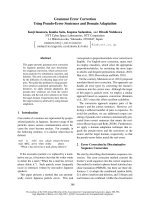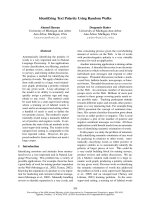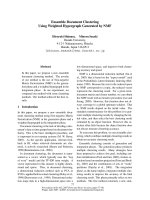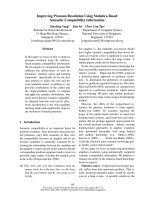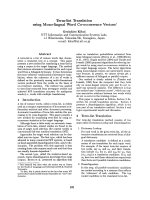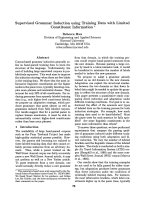Báo cáo khoa học: "WORD-SENSE DISAMBIGUATION METHODS USING STATISTICAL" pot
Bạn đang xem bản rút gọn của tài liệu. Xem và tải ngay bản đầy đủ của tài liệu tại đây (471.86 KB, 7 trang )
WORD-SENSE DISAMBIGUATION USING STATISTICAL
METHODS
Peter F. Brown, Stephen A. Della Pietra, Vincent J. Della Pietra,
and Robert L. Mercer
IBM Thomas J. Watson Research Center
P.O. Box 704
Yorktown Heights, NY 10598
ABSTRACT
We describe a statistical technique for assign-
ing senses to words. An instance of a word is as-
signed a sense by asking a question about the con-
text in which the word appears. The question is
constructed to have high mutual information with
the translation of that instance in another lan-
guage. When we incorporated this method of as-
signing senses into our statistical machine transla-
tion system, the error rate of the system decreased
by thirteen percent.
INTRODUCTION
An alluring aspect of the statistical ~p-
proach to machine translation rejuvenated by
Brown
et al.
[Brown
et al.,
1988, Brown
et al.,
1990] is the systematic framework it provides
for attacking the problem of lexical disam-
biguation. For example, the system they de-
scribe translates the French sentence
Je vais
prendre la ddcision as I will make the decision,
correctly interpreting
prendre as make.
The
statistical translation model, which supplies
English translations of French words, prefers
the more common translation
take,
bnt the
trigram language model recognizes that the
three-word sequence
make the decision,
is much
more probable than
take the decision
The system is not always so successfifl. It
incorrectly renders
Je vais prendre ma propre
ddcision as 1 will take my own decision.
The
language model does not realize that
take my
own decision
is improbable because
take
and
decision
no longer fall within a single trigram.
Errors such as this are common because
the statistical models only capture local phe-
nomena; if the context necessary to determine
a translation falls outside the scope of the
models, the word is likely to be translated in-
correctly, t[owever, if the relevant context is
encoded locally, the word should be translated
correctly. We can achieve this within the tra-
ditional paradigm of analysis, transfer, and
synthesis by incorporating into the analysis
phase a sense-disambiguation component that
assigns sense labels to French words. If
pren-
dre
is labeled with one sense in the context
of
ddcision
but with a different sense in other
contexts, then the translation model will learn
front trMning data that the first sense usually
translates to
make,
whereas the other sense
usuMly translates to
take.
Previous efforts a.t algorithmic disambigua-
tion of word senses [Lesk, 1986, White, 1988,
Ide and V6ronis, 1990] have concentrated on
information that can be extracted from elec-
tronic dictionaries, and focus, therefore, on
senses as determined by those dictionaries.
llere, in contrast, we present a procedure for
constructing a sense-disambiguation compo-
nent that labels words so as to elucidate their
translations in another language. We are con-
264
The proposal
Les propositions
will not
/
ne seront pas
now be implemented
mises en application maintenant
Figure 1: Alignment Example
cerned about senses as they occur in a dic-
tionary only to the extent that those senses
are translated differently. The French noun
intdr~t,
for example, is translated into Ger-
man as either
Zins
or
[nteresse
according to
its sense, but both of these senses are trans-
lated into English as
interest,
and so we make
no attempt to distinguish them.
STATISTICAL TRANSLATION
Following Brown
et al.
[Brown
et al.,
1990],
we choose as the translation of a French sen-
tence F that sentence E for which Pr
(E[F)
is greatest. By Bayes' rule,
Pr (ELF) = Pr (E) Pr
Pr(F)
(1)
Since the denominator does not depend on
E, the sentence for which Pr (El/7') is great-
est is also the sentence for which the product
Pr (E) Pr
(FIE)
is greatest. The first factor
in this product is a statistical characteriza-
tion of the English language and the second
factor is a statistical characterization of the
process by which English sentences are trans-
lated into French. We can compute neither
factors precisely. Rather, in statistical trans-
lation, we employ models from which we can
obtain estimates of these values. We cM1 the
model from which we compute Pr (E) the lan-
guage model and that from which we compute
Pr(FIE ) the translation model.
The translation model used by Brown
et al.
[Brown
et al.,
1990] incorporates the concept
of an
alignment
in which each word in E acts
independently to produce some of the words
in F. If we denote a typical alignment by A,
then we can write the probability of F given
E as a sum over all possible alignments:
Pr
(FIE)
= ~ Pr
(F, AlE ) .
(2)
A
Although the number of possible alignments is
a very rapidly growing function of the lengths
of the French and English sentences, only a
tiny fraction of the alignments contributes sub-
stantiMly to the sum, and of these few, one
makes the grea.test contribution. We ca.ll this
most probable alignment the
Viterbi align-
ment
between E a.nd F.
Tile identity of tile Viterbi alignment for
a pair of sentences depends on the details of
the translation model, but once the model is
known, probable alignments can be discovered
algoritlunically [Brown
et al.,
1991]. Brown
et al.
[Brown
et al.,
1990], show an example
of such an automatically derived alignment in
their Figure 3. (For the reader's convenience,
we ha.re reproduced that figure here as Figure
1.)
265
In a Viterbi alignment, a French word that
is connected by a line to an English word is
said to be
aligned
with that English word.
Thus, in Figure 1,
Les
is aligned with
The,
propositions
with
proposal,
and so on. We call
a p~ir of aligned words obtained in this way a
connection.
From the Viterbi alignments for 1,002,165
pairs of short French and English sentences
from the Canadian Hansard data [Brown
et al.,
1990], we have extracted a set of 12,028,485
connections. Let
p(e, f)
be the probability
that a connection chosen at random fi:om this
set will connect the English word e to the
French word f. Because each French word
gives rise to exactly one connection, the right
marginM of this distribution is identical to
the distribution of French words in these sen-
tences. The left marginal, however, is not
the same as the distribution of English words:
English words that tend to produce several
French words at a time are overrepresented
while those that tend to produce no French
words are underrepresented.
SENSES BASED ON BINARY
QUESTIONS
Using
p(e, f)
we can compute the mutuM
information between a French word and its
English mate in a connection. In this section,
we discuss a method for labelling a word with
a sense that depends on the context in which
it appears in such a way as to increase the
mutual information between the members of
a connection.
In the sentence
Je vats prendre .ma pro-
pre ddeision,
the French verb
prendre
should
be translated as
make
because the obiect of
prendre
is
ddcision.
If we replace
ddcision
by
voiture,
then
prendre
should be translated as
take
to yield
[ will take my own ear.
In these
examples, one can imagine assigning a sense
to
prendre
by asking whether the first noun to
the right of
prendre
is
ddeision
or
voiture.
We
say that the noun to the right is the
informant
for
prendre.
In
I1 doute que les ndtres gagnent,
which
means
He doubts that we will win,
the French
word
il
should be translated as
he.
On the
other hand, in
II faut que les n6tres gagnent,
which means
It is necessary that we win, il
should be translated as
it.
Here, we can de-
termine which sense to assign to
il
by asking
about the identity of the first verb to its right.
Even though we cannot hope to determine the
translation of
il
from this informant unam-
biguously, we can hope to obtain a significant
amount of information about the translation.
As a final example, consider the English
word
is.
In the sentence
I think it is a prob-
lem,
it is best to translate
is
as
est
as in
Je
pense que c'est un probl~me.
However, this is
certainly not true in the sentence
[ think there
is a problem,
which translates as
Je pense qu'il
y aun probl~me.
Here we can reduce the en-
tropy of the distribution of the translation of
is by asking if the word to the left is
there.
If
so, then
is
is less likely to be translated as
est
than if not.
Motivated by examples like these, we in-
vestigated a simple method of assigning two
senses to a word w by asking a single binary
question about one word of the context in
which w appears. One does not know before-
hand whether the informant will be the first
noun to the right, the first verb to the right,
or some other word in the context of w. How-
ever, one can construct a question for each of
a number of candidate informant sites, and
then choose the most informative question.
Given a potential informant such as the
first noun to the right, we can construct a
question that has high mutual information with
the translation of w by using the
flip-flop
algo-
rithm devised by Nadas, Nahamoo, Picheny,
and Poweli [Nadas
et aL,
1991]. To under-
stand their algorithm, first imagine that w is a
French word and that English words which are
possible translations of w have been divided
into two classes. Consider the prol>lem of con-
structing 4. 1)inary question about the poten-
tial inform ant th a.t provides maximal inform a-
tion about these two English word classes. If
the French vocabulary is of size V, then there
266
are 2 v possible questions, tlowever, using the
splitting theorem of Breiman, Friedman, O1-
shen, and Stone [Breiman
et al.,
1984], it is
possible to find the most informative of these
2 v questions in time which is linear in V.
The flip-flop Mgorithm begins by making
an initiM assignment of the English transla-
tions into two classes, and then uses the split-
ting theorem to find the best question about
the potential informant. This question divides
the French vocabulary into two sets. One can
then use the splitting theorem to find a di-
vision of the English translations of w into
two sets which has maximal mutual informa-
tion with the French sets. In the flip-flop al-
gorithm, one alternates between splitting the
French vocabulary into two sets and the En-
glish translations of w into two sets. After
each such split, the mutual information be-
tween the French and English sets is at least
as great as before the split. Since the mutual
information is bounded by one bit, the process
converges to a partition of the French vocab-
ulary that has high mutual information with
the translation of w.
A PILOT EXPERIMENT
We used the flip-flop algorithm in a pilot
experiment in which we assigned two senses to
each of the 500 most common English words
and two senses to each of the 200 most com-
mon French words.
For a French word, we considered ques-
tions about seven informants: the word to the
left, the word to the right, the first noun to
the left, the first noun to the right, the first
verb to the left, the first verb to the right,
and the tense of either the current word, if it
is a verb, or of the first verb to the left of the
current word. For an English word, we only
considered questions about the the word to
the left and the word two to tim left. We re-
stricted the English questions to the l)revious
two words so that we could easily use them
in our translation system which produces an
English sentence from left to right. When
a potential informant did not exist, because,
say there was no noun to the left of some
Word:
Informant:
Information:
prendre
Right noun
.381 bits
Sense 1
TERM_WORD
mesure
note
exemple
temps
initiative
part
Sense 2
d~cision
parole
connaissance
engagement
fin
retr~ite
Common informant values for each sense
Pr(English [ Sense 1) Pr(English
[ Sense 2)
to_take .433
to_make .061
to_do .051
to_be .045
to_make .186
to-speak .105
to_rise .066
to_take .066
to_be .058
decision .036
to-get .025
to_have .021
Probabilities of English translations
Figure 2: Senses for the French word
prendre
word in a particular sentence, we used the spe-
cial word,
TERM_WORD.
To find the nouns
and verbs in our French sentences, we used
the tagging Mgorithm described by MeriMdo
[Merialdo, 1990].
Figure 2 shows the question that was con-
str,cted for tile verb
prendre.
The noun to
the right yielded the most information, .381
bits, about the English translation of
prendre.
The box in the top of the figure shows the
words which most frequently occupy that site,
that is, tile nouns which appear to the right
of
prendre
with a probability greater than one
part in fifty. All instance of
prendre
is assigned
the first or second sense depending on whether
the first noun to the right appears in the left-
ha.nd or the right-hand column. So, for ex-
267
Word:
Informant:
Information:
vouloir
Verb tense
.349 bits
Word:
Informant:
Information:
del)uis
Word to the right
.738 bits
Sense 1
Sense 2
3rd p sing present
1st p sing present
3rd p plur present
1st p pint present
2nd p pint present
3rd p sing imperfect
1st p sing imperfect
3rd p sing future
1st p sing conditional
3rd p sing conditional
3rd p plur conditional
3rd p plur subjunctive
1st p plur conditional
Common informant values for each sense
Sense 1
longtemps
de
UR
quelques
denx
1
plus
trois
Sense 2
le
la
l'
ce
les
1968
Comnmn informant values for each sense
Pr(English[Sense 1) Pr(English [ Sense 2)
to_want .484
to_mean .056
to_be
.056
to_wish .033
to_rear .022
to_like .020
toJike .391
to_want .169
to_have .083
to_wish .066
me .029
Probabilities of English translations
Figure 3: Senses for the French word vouloir
ample, if the noun to the right of prendre is
ddeision, parole, or eonnaissance, then pren-
dre is assigned the second sense. The box at
the bottom of the figure shows the most prob-
able translations of each of the two senses.
Notice that the English verb to_make is three
times as likely when prendre has the second
sense as when it has the first sense. People
make decisions, speeches, and acquaintances,
they do not take them.
Figure 3 shows our results
for
the verb
vouloir. Here, the best informant is the tense
of vouloir. The first sense is three times more
likely than the second sense to translate as
to_want, but twelve times less likely to trans-
late as to_like. In polite English, one says I
would like so and so more commonly than [
would want so and so.
Pr (English I Sense 1) Pr (English I Sense 2)
for .432
last .123
long .102
past .078
over .027
in .022
overdue .021
since .772
from .040
Probabilities of English translations
Figure 4: Senses for the French word depuis
Tile question in Figure 4 reduces the en-
tropy of the translation of the French prepo-
sition depuis by .738 bits. When depuis is fol-
lowed by an article, it translates with proba-
bility .772 to .since, and otherwise only with
probability .016.
Finally, consider the English word cent. In
our text, it is either a denomination of cur-
rency, in which case it is usually preceded by
a number and translated as c., or it is the
second half of per cent, in which case it is pre-
ceded by per and transla,ted along with per as
~0. The results in Figure 5 show that the al-
gorithm has discovered this, and in so doing
has reduced the entropy of the translation of
cent by .378 bits.
268
Word: cent
Informant: Word to the left
Information: .378 bits
Sense 1 Sense 2
per 0
8
5
2
a
one
4
7
Common informant values for each sense
Pr(French I Sense 1) Pr(French [Sense 2)
% .891
c. .592
cent .239
sou
.046
% .022
Probabilities of French translations
Figure 5: Senses for the English word
cent
Pleased with these results, we incorporated
sense-assignment questions for the 500 most
common English words and 200 most com-
mon French words into our translation sys-
tem. This system is an enhanced version of
the one described by Brown
et al.
[Brown
et al.,
1990] in that it uses a trigram lan-
guage model, and has a French vocabulary of
57,802 words, and an English vocabulary of
40,809 words. We translated 100 randomly
selected Hansard sentences each of which is
10 words or less in length. We judged 45
of the resultant translations as acceptable as
compared with 37 acceptable translations pro-
duced by the same system running without
sense-disambiguation questions.
FUTURE WORK
Although our results are promising, this
particular method of assigning senses to words
is quite limited. It assigns at most two senses
to a word, and thus can extract no more than
one bit of information about the translation of
that word. Since the entropy of the transla-
tion of a common word can be as high as five
bits, there is reason to hope that using more
senses will fitrther improve the performance of
our system. Our method asks a single ques-
tion about a single word of context. We can
think of tlfis as the first question in a deci-
sion tree which can be extended to additional
levels [Lucassen, 1983, Lucassen and Mercer,
1984, Breiman
et al.,
1984, Bahl
et al.,
1989].
We are working on these and other improve-
ments and hope to report better results in the
future.
REFERENCES
[Bahl
et aL,
1989] BMd, L., Brown,
P., de Souza, P., and Mercer, R. (1989).
A tree-based statistical language model for
natural language speech recognition.
IEEE
Transactions on Acoustics, Speech and Sig-
nal Processing,
37:1001-1008.
[Breiman
et ai.,
1984] Breiman, L., Fried-
man, J. tI., Olshen, R. A., and Stone,
C. J. (1984).
Classification and Regres-
sion Trees.
Wadsworth & Brooks/Cole Ad-
vanced Books & Software, Monterey, Cali-
fornia.
[Brown
et aL,
1990] Brown, P. F., Cocke, J.,
DellaPietra, S. A., DellaPietra, V. J., Je-
linek, F., Lafferty, J. D., Mercer, R. L.,
and Roossin, P. S. (1990). A statistical ap-
l)roach to machine translation.
Computa-
tional Linguistics,
16(2):79 85.
[Brown
et al.,
1988] Brown, P. F., Cocke, J.,
DellaPietra, S. A., DellaPietra, V. J., Je-
linek, F., Mercer, R. L., and Roossin, P. S.
(1988). A statistical approach to language
translation. I!1
Proceedings of the 12th In-
ternational Conference on Computational
Linguistics,
Budapest, Hungary.
[Brown et
aL,
1991] Brown, P. F., DellaPi-
etra, S. A., DellaPietta, V. J., and Mercer,
R. L. (1991). Parameter estimation for ma-
chine translation. In preparation.
[hie and V@onis, 1990] Ide, N. and V6ronis,
.I. (1990). Mapping dictionaires: A spread-
269
ing activation approach. I:!
Proccedil~!ls of
the Sixth Annual Conferen~:e of the UII'
Centre for the New Oxford English Dictio-
nary and Text Research,
pages 52-6,t, Wa-
terloo, Canada.
[Lesk, 1986] Lesk, M. E. (1986). Auto-
mated sense disambiguation using machine-
readable dictionaries: How to tell a pine
cone from an ice cream cone. In
Proceed-
ings of the SIGDOC Conference.
[Lncassen, 1983] Lucassen, J. M. (1983). Dis-
covering phonemic baseforms automati-
cally: an information theoretic approach.
Technical Report RC 9833, IBM Research
Division.
[Lucassen and Mercer, 1984] Lucassen, J. M.
and Mercer, R. L. (1984). An information
theoretic approach to automatic determi-
nation of phonemic baseforms. In
Proceed-
ings of the IEEE International Conference
on Acoustics, Speech and Signal Processing,
pages 42.5.1-42.5.4, San Diego, California.
[Meria]do, 1990] Merialdo, B. (1990). Tag-
ging text with a probabilistic model. In
Proceedii~gs of the IBM Natural Language
ITL,
pages 161-172, Paris, France.
[Nadas
et
at.,
1991] Nadas, A., Nahamoo,
D., Picheny, M. A., and Powell, J. (1991).
An iterative "flip-flop" approximation of
the most informative split in the construc-
tion of decision trees. In
Proceedings of the
IEEE International Conference on Acous-
tics, Speech and Signal Processing,
Toronto,
Canada.
[White, 1988] White, J. S. (1988). Deter-
mination of lexical-semantic relations for
multi-lingual terminology structures. In
Relational Models of the Lexicon,.
Cam-
bridge University Press, Cambridge, OK.
270
